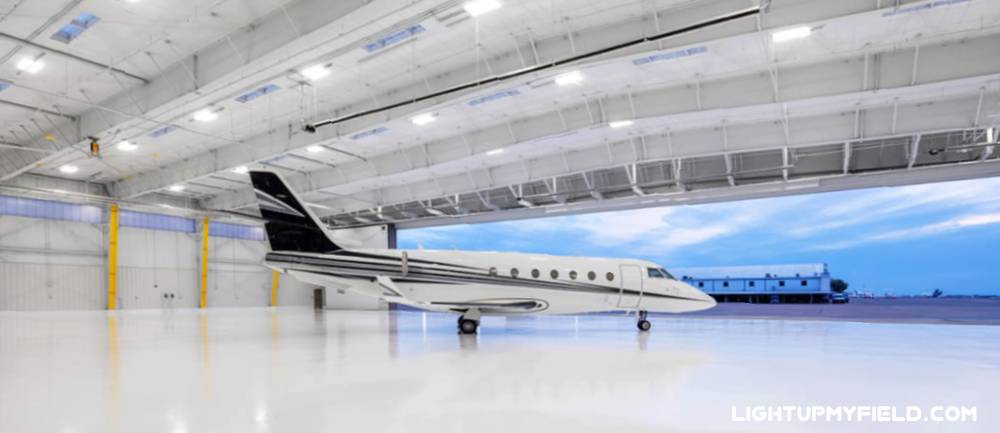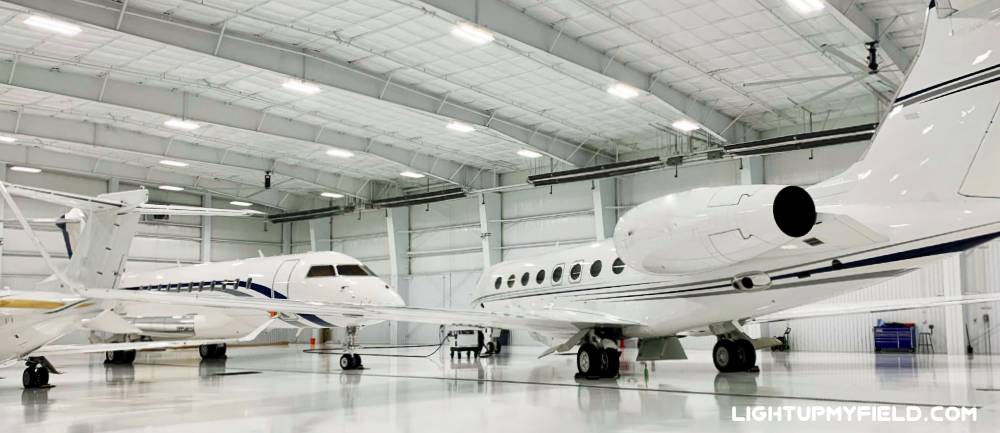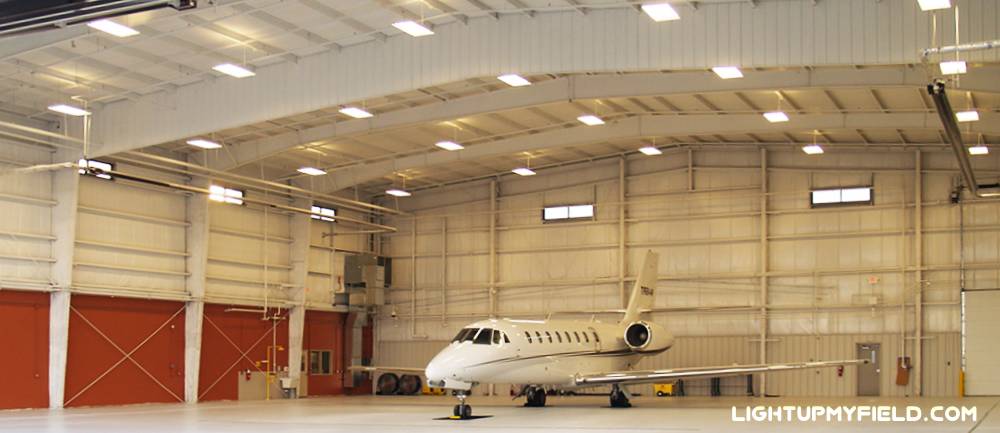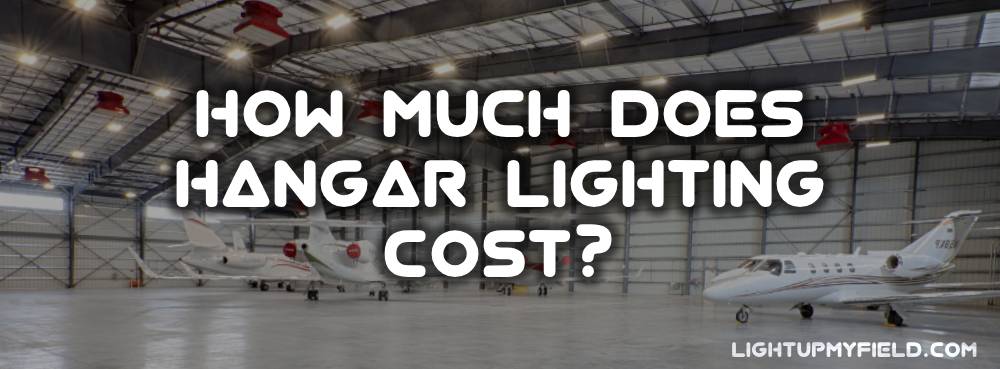Aircraft hangar is huge, and the lighting needs are very different from what you’d find in a warehouse or a workshop. Mechanics need clear, consistent light to check every detail, and pilots need a glare-free environment for safety. All that comes at a price—but how much are we talking about? Let’s break it down step by step.
Table of Contents
ToggleAverage Cost of Hangar Lighting
Before we dive into the details, let’s get a sense of the big picture. Hangar lighting costs usually fall into four main buckets: the price of the fixtures themselves, installation charges, energy bills, and maintenance. Each of these can swing up or down depending on your hangar size, ceiling height, and the type of lights you choose.
| Category | Typical Range | Example (20,000 sq. ft. hangar) |
|---|---|---|
| Fixtures (LED High Bays) | $150 – $400 per fixture | $12,500 – $20,000 for ~50 lights |
| Installation | $100 – $250 per fixture | $5,000 – $12,500 |
| Monthly Energy | LEDs: ~$0.12/kWh | ~$630 (LED) vs ~$1,890 (Metal Halide) |
| Annual Energy | LEDs: ~$7,500 | ~$7,500 (LED) vs ~$22,000 (Metal Halide) |
| Maintenance (10 yrs) | LEDs: Very low (50k–100k hrs lifespan) | Savings of 80–90% vs old tech |
Cost to Buy the Fixtures

Your fixtures will probably be the biggest upfront expense, and this is where most people start. For hangars, high bay LED lights dominate the market because they’re designed for tall ceilings and large spaces. A single high bay LED fixture can range anywhere from $150 to $400, depending on brightness (lumens), durability, and extra features like smart dimming or motion sensors.
So what does that look like in real life? Let’s say you’ve got a 20,000-square-foot hangar with a ceiling height of 30 feet. To hit the recommended lighting levels—around 300 to 500 lux for maintenance areas—you’re likely looking at 40 to 60 fixtures. Each of those might push out 25,000 to 40,000 lumens, enough to flood the space evenly without leaving dark corners under a wing.
If we do the math, at an average of $250 per light and 50 fixtures, you’re looking at roughly $12,500 just for the lights. Go for premium options—maybe with high CRI for color accuracy, specialized beam angles, or IP65 weatherproofing—and that total can easily creep up to $18,000–$20,000 or more. For a large commercial hangar, it’s not unusual for lighting alone to cross the $30,000 mark.
Installation Costs
Getting those lights up there? That’s where the next big chunk comes in. Hangar ceilings aren’t exactly easy to work with. Most electricians charge by the fixture, and for high bay lights, the rate typically falls between $100 and $250 per fixture, including wiring and mounting. If your hangar needs 50 fixtures, your labor bill could land somewhere between $5,000 and $12,500.
The exact number depends on whether your existing setup is LED-ready or not. If you’re upgrading from old fluorescents or metal halides, you might need rewiring, removing old ballasts, or even adding extra circuits, which all add to the cost. On the flip side, if the wiring is in good shape and you’re basically swapping fixtures, you’ll be closer to the lower end of that range.
One thing to keep in mind: lifts or scaffolding for ceilings that are 30 or 40 feet up can cost extra if your installer needs to bring equipment. Some companies roll this into their price, but others will itemize it.
Running Costs: What You’ll Pay on the Power Bill
Here’s where things get interesting—and where LEDs shine. Energy use for high bay lights depends on wattage and how long the lights stay on. A typical high bay LED draws about 200–300 watts, while an older metal halide fixture might pull anywhere from 400 to 1,000 watts. That’s a massive difference.
Let’s run a real example: If you have 50 LED fixtures rated at 250 watts, that’s a total load of 12.5 kW. Run them for 14 hours a day, 7 days a week (pretty normal for busy hangars), and you’re using about 175 kWh per day. Multiply that by 30, and your monthly usage comes out to 5,250 kWh. At an average electricity cost of $0.12 per kWh, that’s around $630 per month.
Now, imagine sticking with metal halides at 750 watts each. That’s 37.5 kW of load, which works out to over 15,750 kWh per month, or a power bill of about $1,890. That’s $1,200 more every single month—or $14,000 a year—just for the privilege of using old tech. This is why most hangar operators don’t even hesitate to switch to LEDs.
Maintenance Cost Over Time
Nobody enjoys swapping out a bulb 40 feet up in the air, especially when it means renting a lift and paying for labor. With old HID or fluorescent lights, you’ll probably be changing lamps every 12 to 18 months, and each trip might cost a few hundred dollars once you factor in the electrician’s time and equipment rental.
LEDs flip that equation. Most decent models are rated for 50,000 to 100,000 hours, which, if you’re running 14 hours a day, is roughly 10 years before you need a full replacement. Sure, you might need the occasional driver swap or a cleaning, but that’s peanuts compared to replacing dozens of bulbs every year. Over the life of the lights, you can expect maintenance costs to drop by 80–90% with LEDs. That’s thousands saved—not to mention way fewer headaches.
Factors Affecting the Cost

The price tag for lighting a hangar isn’t a one-size-fits-all deal. Several things can nudge that number up or down—sometimes by tens of thousands of dollars. Let’s break down what really drives the cost and why these details matter.
Size of the Hangar
This one’s pretty obvious, but it’s worth spelling out: bigger spaces need more lights, more wiring, and more power. A small private hangar of around 5,000 square feet might get by with 10–12 LED fixtures, which means maybe $3,000 for lights and another $1,500 for installation. Not bad, right?
Now compare that to a 50,000-square-foot commercial hangar. To maintain the same lighting level—let’s say 350 lux across the floor—you’re probably looking at 80–120 high bay fixtures. At an average of $250 per light, that’s $20,000 to $30,000 in fixtures alone, and the installation bill can jump to $10,000 or more. Just the jump in size could turn a $5K project into a $50K one.
Ceiling Height
The higher the ceiling, the more intense the light you’ll need. For example, hangars over 25 feet almost always need high bay lights, which typically produce 20,000–60,000 lumens per fixture. These lights are built to project strong beams over long distances without losing brightness.
Smaller hangars with ceilings under 20 feet can usually go with low bay lights, which cost a little less because they don’t need that punch. But if you try using low bays in a 35-foot hangar, you’ll end up with a dim floor and wasted energy. And on the flip side, high bays in a 15-foot hangar? Get ready for blinding glare and hot spots. The wrong choice can burn through your budget and still give you lousy lighting.
Direct vs. Indirect Lighting
Here’s another big cost factor: how you want the light delivered. Direct lighting—where beams point straight down—is cheaper and more efficient to install. It needs fewer fixtures and less energy to hit your target lux levels.
Indirect lighting, on the other hand, is like the luxury option. It bounces light off walls or ceilings for a softer, glare-free effect, which is great for working around shiny aircraft surfaces. The trade-off? You’ll need more fixtures, more wattage, and probably more labor for angled mounting or wall brackets. For a large hangar, going indirect could easily add 20–30% to your total cost.
Spacing and Beam Angle
Spacing might sound like a minor detail, but it can make or break your setup—and your budget. If fixtures are spaced too far apart or the beam angle is too narrow, you’ll get dark spots under wings and around landing gear. Fixing that usually means adding extra lights or upgrading to fixtures with custom optics, which cost more.
For example, a standard high bay with a 90° beam might cover a 20-foot radius effectively, but if your hangar is packed with tall aircraft, you might need 60° optics for focused beams or 120° for wide coverage. The choice here can add anywhere from $30 to $100 per fixture for specialized lenses.
Electrical Infrastructure
This is the sneaky cost people forget about. If your hangar is older or wasn’t designed for heavy lighting loads, you might need to upgrade wiring, add circuits, or install new panels. That’s not cheap. Electrical work can easily run $50–$100 per hour, and a full upgrade could tack on $5,000 to $15,000.
If you’re retrofitting from fluorescent or metal halide to LED, the good news is you might be able to reuse some wiring, but removing old ballasts and prepping mounts still adds labor hours.
Climate and Environment
Yep, where your hangar is located matters too. Harsh environments—like coastal areas with salty air or regions with extreme cold—need fixtures with higher IP ratings and corrosion-resistant coatings. Those can cost 10–20% more per unit, but skipping that protection could mean replacing your lights in a couple of years instead of a decade.
If your hangar is in a dusty area or used for heavy maintenance, you might also need dust-proof or explosion-proof fixtures, which can run $400 to $800 each, compared to $200 for a standard high bay.
Lighting Controls and Automation
Want to save money long-term? Smart lighting systems with motion sensors, dimming, and daylight harvesting are the way to go. But upfront, they add cost. For example, adding wireless controls could cost an extra $50–$100 per fixture. For a 50-fixture hangar, that’s another $2,500 to $5,000.
It sounds like a lot, but if those controls shave 30% off your power bill, you’ll earn that back pretty fast.
Tips to Save on Hangar Lighting Costs

Lighting up a hangar isn’t exactly pocket change, but there are plenty of smart moves to keep costs under control without compromising on brightness or safety. A few strategic decisions upfront can save you thousands in the long run.
Go LED Right Away
It might feel tempting to go with cheaper fixtures at first, but that almost always backfires. LED lights cost more upfront, usually $150 to $400 per fixture, but they pay for themselves quickly because of energy savings. A typical metal halide fixture runs at 750 watts, while an LED alternative might use only 250 watts for the same light output. That’s a 67% reduction in energy use.
Let’s do the math: if your hangar uses 50 fixtures and runs lights 14 hours a day, that’s about 255,000 kWh per year for metal halide vs. 87,500 kWh for LED. At $0.12 per kWh, that’s $30,600 a year with old lights versus $10,500 with LEDs. Boom—$20,000 saved annually just by switching. Most hangars see a return on investment in one to three years, and after that, the savings just keep stacking up.
Add Smart Controls
Think about how often your hangar is actually full of people working. If it’s not 24/7, then you’re probably wasting money lighting empty space. Adding motion sensors, dimmers, or scheduling systems can cut energy use by 20–30%. For a large hangar spending $10,000 a year on electricity, that’s another $2,000 to $3,000 off the bill.
Some modern systems even let you control lights from an app or integrate with daylight sensors so they dim when natural light floods in. Yes, there’s an extra upfront cost—about $50 to $100 per fixture for controls—but the payoff is quick, especially for hangars with sporadic activity.
Get the Layout Right Before You Buy
This is the step a lot of people rush through, and it ends up costing them later. A bad layout means dark spots under wings, glare in people’s eyes, and wasted energy. Sometimes the fix is adding more fixtures, which means more money out the door.
Investing in a professional lighting design—or at least using good planning tools—can help you get the right beam angles, fixture spacing, and mounting heights from the start. For example, a well-planned layout might need 45 fixtures instead of 60, and that’s a $3,750 difference if your fixtures cost $250 each. That’s not small change.
Look for Rebates and Incentives
Here’s free money most people forget about: energy-efficiency rebates. Utility companies, local governments, and even some federal programs offer incentives for upgrading to LED or adding smart controls. Depending on your area, rebates can cover 10–30% of your total project cost.
So if your lighting upgrade is $30,000, you could get $3,000 to $9,000 back just by filling out a form. Some programs even offer on-bill financing, so you spread the cost over time while still seeing lower energy bills right away. It’s definitely worth checking before you start writing checks.
So, What’s the Total?
Let’s talk real numbers, because that’s what most people want to know before diving into a big project like this. If you’ve got a medium-sized hangar around 20,000 square feet, expect to spend anywhere between $20,000 and $40,000 just for the lighting setup—fixtures plus installation. The range depends on whether you go for standard LED high bays or premium models with extras like dimming, smart controls, and weatherproofing.
Now, on top of that, you’ll have your energy bill to think about. With modern LED high bays, running lights 14 hours a day will cost you roughly $7,000 to $8,000 per year at average electricity rates. Compare that to older metal halide systems, where the same setup could easily eat up $18,000 to $20,000 annually. That’s why LEDs are such a no-brainer—your first couple of years basically pay for the upgrade through savings alone.
If your hangar is bigger—say 50,000 square feet or more—don’t be surprised if the upfront cost jumps into the $60,000 to $100,000 range, depending on your layout and how fancy you get with controls. On the flip side, a smaller private hangar of 5,000 square feet might only need $5,000 to $10,000 worth of lights and labor.
And remember, this is before rebates and incentives, which can knock 10–30% off the cost in many areas. So always check what’s available locally—it’s basically free money for going energy-efficient.
Bottom line? Going cheap on lighting upfront might look good on paper, but in the long run, it’s like throwing money out the window. Spend smart now, and you’ll save thousands later.
Looking Ahead
Lighting a hangar is an investment in safety, efficiency, and long-term savings. Going cheap often backfires, while smart choices—like LEDs and good design—pay off big in the long run. If you plan it right, you can create a bright, comfortable workspace and keep energy bills from eating into your budget.

